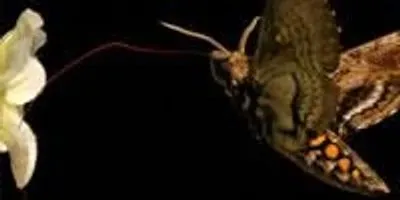 A hawk moth probes a flower with its proboscis.Photo credit: Armin HinterwirthA new study involving hawk moths – a close relative of the species made famous by the film “Silence of the Lambs” – was published April 15 in the British Ecological Society‘s journal Functional Ecology.
A hawk moth probes a flower with its proboscis.Photo credit: Armin HinterwirthA new study involving hawk moths – a close relative of the species made famous by the film “Silence of the Lambs” – was published April 15 in the British Ecological Society‘s journal Functional Ecology.
Since long before Charles Darwin, ecologists have been fascinated by flower shape, and in particular how animal pollinators have shaped the evolution of floral traits.
But studying the impact of flower shape on pollinator behavior is difficult.
Ecologists have either relied on plant breeding (which means they can only study flower shapes found in nature) or have made flowers by hand from papier mache (which can be time consuming and could make it difficult for ecologists to test each other’s results).
Now, graduate student Eric Octavio Campos and fellow UW biologists have used 3-D printing to make artificial flowers so they can investigate how flower shape affects foraging behavior in the hawk moth, or Manduca sexta.
Also known as the tobacco hornworm because the larvae feed on tobacco, the hawk moth is common in the southern and southeastern regions of the U.S. With a thumb-sized body and fist-sized wingspan, adult moths are adept at flying and hovering, which they do to feed from trumpet-shaped flowers such as petunias.
The researchers made flowers of two different shapes, one curved like a trumpet and the other a flat disc with a hole in the center. After filling each artificial flower with sugar water to simulate a real flower’s nectar, they arranged equal numbers of curved and flat flowers on a square grid. They then allowed hawk moths to fly freely around the artificial flowers for five minutes and compared how many of each flower shape the moths emptied.
 Artificial flowers created by 3D printing.Photo credit: Eric Octavio Campos“With their long proboscis and nocturnal habits, finding a flower’s nectar source isn’t easy for the fist-sized hawk moths we used in our study,” Campos said. “Imagine being given a garden hose that’s almost twice your height in length. Now imagine trying to thread the other end through a hole that’s scarcely wider than the hose itself – at dusk as the sun is setting or at night during a full moon. It may seem like a silly proposition, but it’s not too far off from what night-flying hawk moths have to contend with to get a meal.”They found the moths fed much more successfully from the curved than the flat flowers, which suggests that this nocturnal species is using touch rather than sight as the primary means of finding nectar.
Artificial flowers created by 3D printing.Photo credit: Eric Octavio Campos“With their long proboscis and nocturnal habits, finding a flower’s nectar source isn’t easy for the fist-sized hawk moths we used in our study,” Campos said. “Imagine being given a garden hose that’s almost twice your height in length. Now imagine trying to thread the other end through a hole that’s scarcely wider than the hose itself – at dusk as the sun is setting or at night during a full moon. It may seem like a silly proposition, but it’s not too far off from what night-flying hawk moths have to contend with to get a meal.”They found the moths fed much more successfully from the curved than the flat flowers, which suggests that this nocturnal species is using touch rather than sight as the primary means of finding nectar.
By showing how 3-D printing can be used to make artificial flowers, the research opens up new ways for ecologists to study animal pollinators and the evolutionary role they play in shaping the flowers we see in nature today.
“3-D printing is a unique opportunity to explore the interactions between floral form and pollinator performance,” Campos said. “Such studies can help elucidate the details of how pollinator visitation influences the evolution of floral shape in nature, and the extent to which floral forms are the result of specializations between one plant and one pollinator species.”
Co-authors are Toby Bradshaw, chair and professor of biology, and Tom Daniel, professor of biology and director of the new Air Force Center of Excellence on Nature-Inspired Flight Technologies and Ideas at the UW.
The research was funded by the Office of Naval Research, the National Institutes of Health and a National Science Foundation Graduate Research Fellowship.
A new study involving hawk moths – a close relative of the species made famous by the film “Silence of the Lambs” – was published April 15 in the British Ecological Society‘s journal Functional Ecology.
Since long before Charles Darwin, ecologists have been fascinated by flower shape, and in particular how animal pollinators have shaped the evolution of floral traits.
But studying the impact of flower shape on pollinator behavior is difficult.
Ecologists have either relied on plant breeding (which means they can only study flower shapes found in nature) or have made flowers by hand from papier mache (which can be time consuming and could make it difficult for ecologists to test each other’s results).
To continue reading this article, sign up for FREE to

Membership is FREE and provides you with instant access to eNewsletters, digital publications, article archives, and more.













